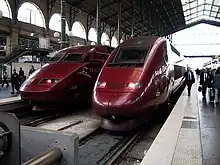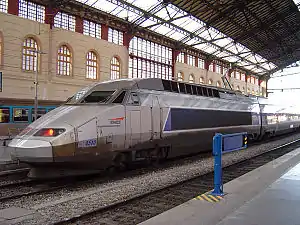SNCF TGV Réseau
The SNCF TGV Réseau (TGV-R) trains were built by Alstom between 1992 and 1996. These TGV trainsets are based on the earlier TGV Atlantique.
| SNCF TGV "Réseau" | |
|---|---|
.jpg.webp) TGV-R set approaching Paris Gare du Nord | |
| In service | 1993 - |
| Manufacturer | GEC-Alsthom |
| Family name | TGV |
| Number built | 90 trainsets |
| Number in service | 66 |
| Formation | 10 cars (2 power cars, 8 passenger cars) |
| Capacity | 377, 361 (after refurbishment) |
| Operator(s) | SNCF Thalys |
| Specifications | |
| Train length | 200.19 m (656 ft 9+1⁄2 in) |
| Width | Motor car 2.81 m (9 ft 2+5⁄8 in) Trailer 2.904 m (9 ft 6+5⁄16 in) |
| Maximum speed | 320 km/h (199 mph) (Service) |
| Weight | 383 t (377 long tons; 422 short tons) (dual voltage) |
| Power output | 8,800 kW (11,801 hp) @ 25 kV |
| Electric system(s) | Overhead lines 25 kV 50 Hz AC 1,500 V DC 3 kV DC |
| Current collector(s) | Pantograph |
| UIC classification | Bo'Bo'+2'2'2'2'2'2'2'2'2'+Bo'Bo' |
| Safety system(s) | TVM-430, ERTMS level 2, KVB, LZB, PZB |
| Track gauge | 1,435 mm (4 ft 8+1⁄2 in) standard gauge |
The first Réseau ("Network") sets entered service in 1993. Fifty dual-voltage trainsets were built in 1992-1994, numbered 501-550. A further 40 triple-voltage trainsets, numbered 4501-4540, were built in 1994-1996. The last ten of these triple voltage units carry the Thalys livery and are known as Thalys PBA (Paris-Brussels-Amsterdam) sets. As well as using standard French voltages of 25 kV AC and 1,500 V DC (also used in the Netherlands), the triple voltage sets can operate under the Belgian and Italian 3 kV DC supplies.
They are formed of two power cars (8,800 kW (11,801 hp) under 25 kV—like the TGV Atlantique) and eight carriages, giving a capacity of 377 seats. They have a top speed of 320 km/h (199 mph). They are 200.19 m (656 ft 9+1⁄2 in) long and are 2.904 m (9 ft 6+5⁄16 in) wide. The dual-voltage sets weigh 383 t (377 long tons; 422 short tons), and owing to axle-load restrictions in Belgium the triple-voltage sets have a series of modifications, such as the replacement of steel with aluminium and hollow axles, to reduce the weight to under 17 t (16.7 long tons; 18.7 short tons) per axle. Owing to early complaints of uncomfortable pressure changes when entering tunnels at high speed on the LGV Atlantique, the Réseau sets are pressure-sealed.
In 2006 the carriages of nineteen sets were used to form TGV POS sets by using new TGV POS motorcars for services on the LGV Est to Germany and Switzerland. The 38 replaced Réseau motorcars were slightly modified and joined to new Duplex carriages, forming nineteen TGV Réseau Duplex units. They now operate as part of the TGV Duplex fleet, being numbered 601-619.
Renovation
After some ten years of successful service, the interior of TGV Réseau sets became outdated and needed a refurbishment. This refurbishment was part of the TGV Est project, as the dual-voltage sets were to assure the domestic services there. The same interiors would also be used in the coaches for POS sets.
Three possible interiors were presented to the public between 2002 and 2003 in different stations:
- Recaro which teamed up with Brand Company (designer of the "snail" TGV logo)
- MBD Design (designer of the noses of Alstom's Prima locomotives and the TGV Duplex) which teamed up with fashion designer Christian Lacroix.
- Antolin which teamed up with Kenzo.
At the end of the Train Capitale exposition in Paris, MBD Design and Christian Lacroix were announced as the winning design.
Work started on the first dual-voltage sets in 2004 at SNCF's Hellemmes workshops, near Lille. In 2006 the last dual-voltage set was finished. Between 2008 and 2009 the three-voltage sets will also be refurbished in the same design. The refurbished sets can be distinguished from the non-refurbished ones by: the slightly changed livery; the fittings in the coaches, which are in new colours (red for 2nd class, yellow-green for 1st class and silver for the bar) and the reflecting stripes on the sides of the motorcars.
Although SNCF announced in July 2007 that the Lacroix-design would not be continued because some materials vibrated at 300 km/h (186 mph), this was later changed: the Lacroix-design will be applied to all TGV Réseau sets.
Fleet details
| Class | No. in Service | Year Built | Operator | Current Units | Notes |
|---|---|---|---|---|---|
| Series 28000 | 30 | 1992–1996 | SNCF | 501, 503-514, 534-550 | Dual-voltage |
| Series 38000 | 27 | 4501-4506, 4510-4529, 4551 | Triple-voltage | ||
| 9 | Thalys | 4532-4540 |
Gallery
 Thalys PBA alongside PBKA at Paris Gare du Nord
Thalys PBA alongside PBKA at Paris Gare du Nord Triple-voltage TGV-R set 4510 at Marseille St-Charles station
Triple-voltage TGV-R set 4510 at Marseille St-Charles station 1st class interior of a refurbished TGV-Réseau set
1st class interior of a refurbished TGV-Réseau set 1st class interior of a refurbished TGV-Réseau set
1st class interior of a refurbished TGV-Réseau set 2nd class interior of a refurbished TGV-Réseau set
2nd class interior of a refurbished TGV-Réseau set Cab view riding at 313 km/h.
Cab view riding at 313 km/h. A TGV Reseau trainset stops at Champagne Ardennes TGV.
A TGV Reseau trainset stops at Champagne Ardennes TGV.
See also
- List of high speed trains
- KTX-I — derived design used in Korea